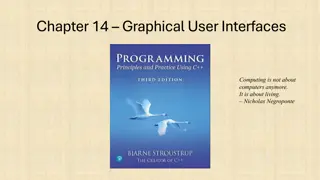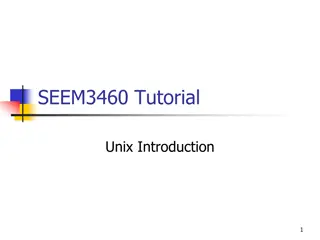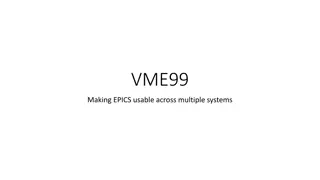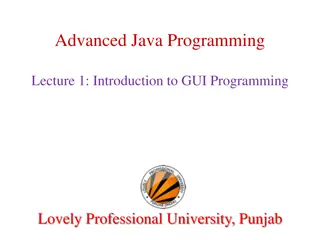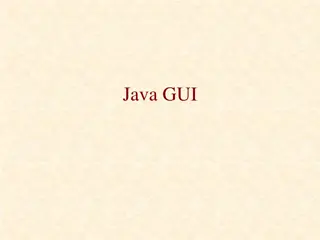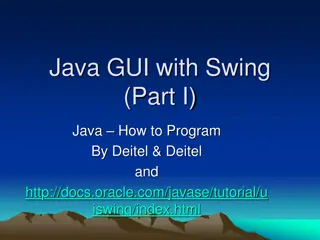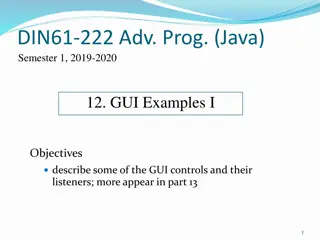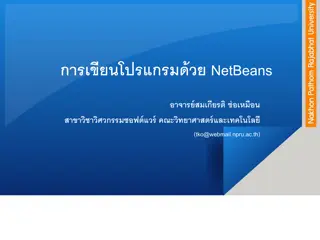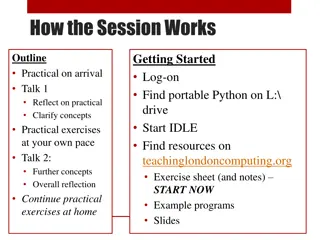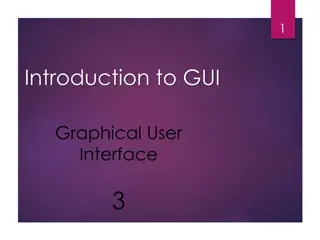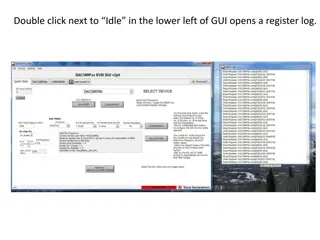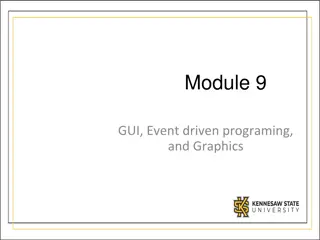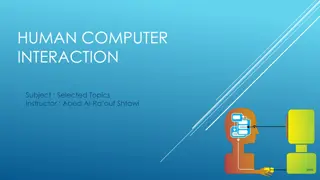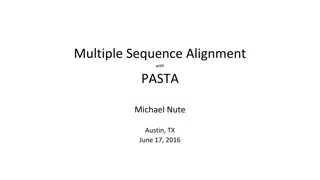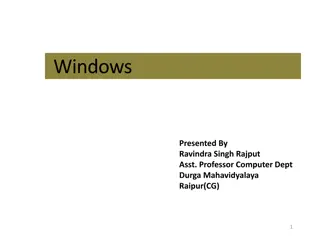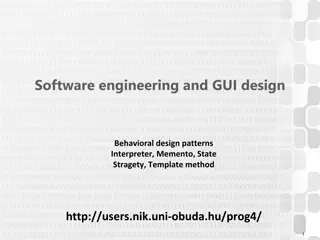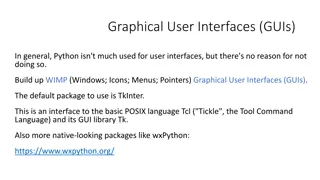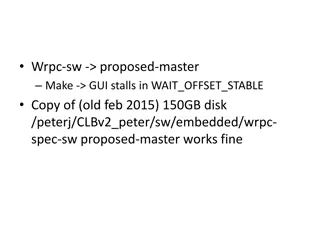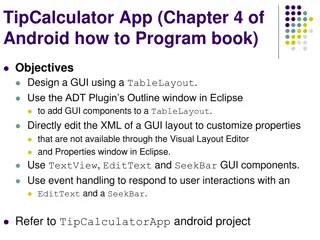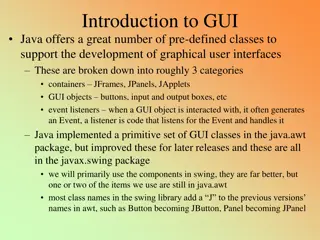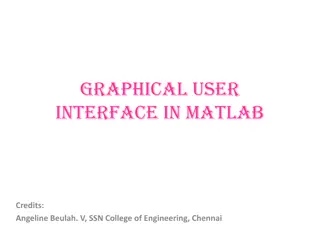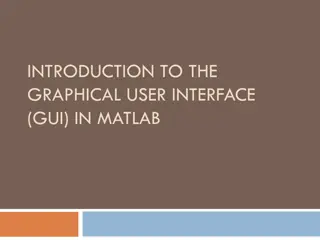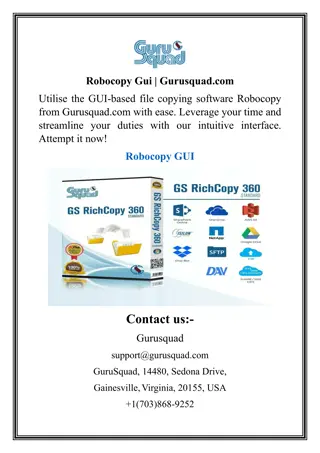Kunming Gui Gu Flower Planting Co., Ltd. - Preserved Flowers & Humidifier Product
Kunming Gui Gu Flower Planting Co., Ltd. is a leading enterprise specializing in preserved flowers, offering a variety of exquisite preserved flower products. Their latest product, a Humidifier with built-in colorful lights, is designed to adjust indoor humidity while adding a touch of beauty to any
0 views • 45 slides
Evolution of Mathematical Theories and Proof Systems
Development of mathematical theories such as model theory, proof theory, set theory, recursion theory, and computational complexity is discussed, starting from historical perspectives with Dedekind and Peano to Godel's theorems, recursion theory's golden age in the 1930s, and advancements in proof t
1 views • 29 slides
The Evolution of Graphical User Interfaces in Computing
Graphical User Interfaces (GUIs) have transformed computing into a more user-friendly and interactive experience, emphasizing the shift from technology-focused to human-centric living. This chapter delves into the various aspects of GUIs, including I/O alternatives, common GUI tasks, programming per
1 views • 32 slides
Psychological Theories of Criminality: Understanding the Roots
Psychological theories of criminality delve into the association between intelligence, personality, learning, and criminal behavior. Major theories include Psychodynamic Theory by Freud, Behavioral Theory by Bandura, and Cognitive Theory by Kohlberg. These theories explore how unconscious mental pro
1 views • 20 slides
Introduction to Unix-like Systems and Shell Interaction
Unix-like systems, such as Linux, Android, iOS, and macOS, are prevalent in various devices. The Unix shell acts as an intermediary between users and the operating system, allowing for program execution and process management. Secure Shell (SSH) and X Window System enable remote machine connections
4 views • 19 slides
Understanding the Theory of Firms: Neoclassical vs. Modern Approaches
The theory of firms is explored through the Neoclassical and Modern perspectives. Neoclassical theory focuses on profit maximization, while Modern theory delves into managerial, principal-agent, and transaction cost theories. The discussion covers criticisms of Neoclassical theory and the essential
1 views • 79 slides
Theories of Causation in Psychological and Social Sciences
Overview of theories of causation categorized into psychological, social psychological, and sociological perspectives. Psychological theories focus on instinctive, biological, and psychological qualities of abusers, including Attachment Theory, Psychodynamic Theory, Social Learning Theory, and Situa
0 views • 15 slides
Understanding Political Theory through a Contextual Approach
Exploring G.H. Sabine's perspective on political theory through a contextual approach, emphasizing the importance of historical context and societal influences. Sabine argues that while political theory evolves with its contemporary politics, it should be analyzed within its specific time and social
0 views • 9 slides
Evolution of Light Theory: From Wave Theory to Quantum Theory
At the turn of the century, the discovery of the photoelectric effect challenged the wave theory of light, leading to the development of the quantum theory by Max Planck and Albert Einstein. This new theory introduced the concept of discrete energy units known as quanta, bridging the gap between wav
1 views • 62 slides
Dp-branes, NS5-branes, U-duality, and M-Theory Overview
Overview of Dp-branes, NS5-branes, and U-duality derived from nonabelian (2,0) theory with Lie 3-algebra. Introduction to M-theory, including M2-branes and M5-branes in the strong coupling limit. Discussion on BLG theory, Lorentzian Lie 3-algebra, and the ABJM theory for M2-branes.
1 views • 32 slides
Challenges and Solutions in Using EPICS for Digital DAQ Systems
Digital DAQ systems based on EPICS face issues with version control, data reading, trigger handling, and GUI consistency. Solutions involve code optimization, improving trigger management, and enhancing GUI design for better user experience.
2 views • 5 slides
Comparison of GUI-Based and Text-Based Assignments in CS1
This study investigates the effectiveness of GUI-based assignments compared to text-based assignments in a CS1 course. The research explores how student motivation impacts their performance and retention in the course. It also delves into student preferences between GUI-based and text-based assignme
0 views • 19 slides
Understanding Time-Independent Perturbation Theory in Quantum Mechanics
Perturbation theory is a powerful tool in solving complex physical and mathematical problems approximately by adjusting solutions from a related problem with known solutions. This theory allows for more accurate approximate solutions by treating the difference as a small perturbation. An example inv
0 views • 19 slides
Ethical Theories: Divine Command vs. Virtue Theory Explained
Divine Command Theory asserts that morality is derived from God's commands, contrasting with Virtue Theory which focuses on developing moral virtues to achieve human flourishing and excellence. Divine Command Theory relies on religious texts, while Virtue Theory emphasizes the cultivation of virtues
0 views • 24 slides
Understanding AWT and Swing for GUI Programming in Java
Explore the differences between AWT and Swing for building graphical user interfaces in Java. Learn how Swing components offer more flexibility and platform independence compared to AWT, with features like pluggable look-and-feel support and internationalization. Dive into the key features of Swing
0 views • 59 slides
Introduction to Java GUI Programming
Java GUI programming involves transitioning from AWT to Swing, utilizing prebuilt components, and understanding the anatomy of a GUI application. Learn how to create, configure, and interact with GUI components such as buttons and labels, and build applications from the bottom up. Explore sample cod
0 views • 19 slides
Exploring Graphical User Interfaces (GUIs) and JOptionPane in Java
Introduction to Object-Oriented Programming (OOP) and GUI concepts in Java, focusing on GUI hierarchy, designing GUIs, working with containers and components, utilizing JOptionPane for graphical input/output, and examples of showMessageDialog and showConfirmDialog in Java applications.
0 views • 90 slides
Introduction to Java GUI with Swing Part I
Understanding Java GUI components with Swing and AWT, top-level containers, containment hierarchy concepts, menu bars, content panes, and component hierarchy. Exploring various container classes and their roles in GUI programming.
1 views • 64 slides
Overview of Java Socket Programming and GUI APIs
Java Socket Programming facilitates data sharing between computing devices through client-server communication using sockets. This tutorial covers topics on Socket Programming, establishing socket connections, and a demo showcasing client-server interactions. Additionally, it explores GUI APIs like
0 views • 25 slides
An Overview of GUI Controls in Java Programming
Explore the different GUI controls in Java programming, including buttons, text fields, checkboxes, radio buttons, combo boxes, and more. Learn about the three main steps in creating a GUI, the Swing GUI overview, and various categories of Swing components with code examples.
0 views • 62 slides
Overview of GUI Development Using NetBeans and Java
Explore the world of GUI development with NetBeans IDE and Java. Learn about building graphical user interfaces, utilizing event listeners, JDBC APIs, frameworks, and visual designers. Follow along with step-by-step instructions and visual examples to enhance your Java programming skills.
0 views • 22 slides
Introduction to GUI Programming in Python
Explore the key concepts and practical application of creating Graphical User Interfaces (GUIs) in Python using widgets, events, attributes, and layouts. Learn how to modify and create widgets, handle events, and utilize object-oriented programming for GUI development.
0 views • 26 slides
Understanding GUI Layout Managers in Java
Exploring the concepts of GUI layout managers in Java, including how to place GUI objects on a frame using different layout managers such as FlowLayout, GridLayout, and BorderLayout. This guide covers the functionality and characteristics of each layout manager to help you effectively design graphic
0 views • 26 slides
Understanding GUI Functionality for Register Log and Configuration Saving
This guide explains the steps to open a register log by double-clicking next to Idle in the lower left of a GUI and saving configurations by clicking on the floppy icon. The process involves CW settings, registers writes, and how the cfg file stores LMK and DAC settings.
0 views • 4 slides
Understanding GUI, Event-Driven Programming, and Graphics in Java/C#
Graphical User Interfaces (GUIs) play a crucial role in modern programming, allowing users to interact visually with applications. This module covers the basics of GUI design, frontend vs. backend coding, common GUI components, and layout positioning. GUIs, when well-designed, enhance user experienc
1 views • 28 slides
Understanding Human-Computer Interaction: CLI vs. GUI
Explore the evolution of Human-Computer Interaction (HCI) from its history to the advent of Command Line Interfaces (CLI) and Graphical User Interfaces (GUI). Learn about the advantages, disadvantages, applications, and how CLI and GUI differ in user interaction paradigms.
0 views • 19 slides
Understanding Multiple Sequence Alignment with PASTA Algorithm
Explore the PASTA algorithm for multiple sequence alignment, from installation to using the GUI for alignment and tree estimation. Learn about SAT and PASTA algorithms, the input process, and the steps involved in obtaining the best ML score alignment/tree pair. Dive into the PASTA GUI, initial alig
0 views • 19 slides
Automatically Repairing Broken Workflows for GUI Applications
Repairing broken workflows caused by GUI evolution in evolving applications is crucial for maintaining user experience and automated testing integrity. This research focuses on automatically suggesting replacement actions to adapt to changing interfaces without altering the underlying code, addressi
0 views • 40 slides
Understanding GUI in Windows Operating System
Graphical User Interface (GUI) in Windows operating system is visually represented through icons, pointers, menus, and desktop elements. GUI standards ensure consistency across systems. Icons, cursors, and windows play key roles, allowing users to interact with applications efficiently. Learn how GU
0 views • 43 slides
Guide to Behavioral Design Patterns in Software Engineering and GUI Design
Learn about key behavioral design patterns such as Interpreter, Memento, State, Strategy, and Template Method in software engineering and GUI design. Understand their purposes, implementation techniques, and when to use them effectively. Explore how these patterns enhance the design and functionalit
0 views • 42 slides
Python GUI Development: Creating User-Friendly Interfaces
Python can be effectively used for creating Graphical User Interfaces (GUIs) by leveraging libraries like Tkinter and wxPython. This guide covers GUI design principles, event-based programming, and tips for enhancing the user experience. It emphasizes the importance of designing intuitive interfaces
0 views • 6 slides
Troubleshooting GUI Stalls and Git Updates in Wrpc-sw Repository
Resolve issues related to GUI stalls and Git updates in the Wrpc-sw repository. Includes guidance on checking out specific commits, submodule initialization, and updating. Also addresses update functions, state management, and configuration settings in the code.
0 views • 25 slides
Theories of Interest in Microeconomics II
Explore various theories of interest in economics, including the Classical Theory, Liquidity Preference Theory by Keynes, Productivity Theory, Abstinence Theory, Time-Preference Theory, Fisher's Time Preference Theory, and the Loanable Fund Theory. These theories offer different perspectives on the
0 views • 6 slides
Android GUI Design and Event Handling with TableLayout, SeekBar, and EditText
Learn how to design a GUI using TableLayout in Android, customize properties through XML, utilize TextView, EditText, and SeekBar components, and handle user interactions with EditText and SeekBar. Explore the application manifest file, creating Toast notifications, adapting to screen orientation ch
0 views • 20 slides
Overview of GUI Components and Creating GUI in Java
In Java, GUI development is facilitated by a variety of pre-defined classes categorized into containers like JFrames and JPanels, GUI objects such as buttons and input boxes, along with event listeners for user interactions. The javax.swing package offers enhanced GUI classes compared to java.awt. K
0 views • 17 slides
Understanding Layout Managers in Java Swing GUI Development
In Java Swing GUI development, layout managers play a crucial role in arranging components within a container. This content delves into BorderLayout, GridLayout, and FlowLayout managers, explaining their characteristics and usage. Additionally, it mentions the importance of BoxLayout for advanced GU
0 views • 26 slides
Understanding Immediate Mode GUI: Theory, Implementation, and Example
Graphical User Interface (GUI) is a key element in software development, facilitating user interaction and displaying information. This content delves into GUI theory, discussing its architecture, implementation methods, object-oriented approach, and the concept of immediate mode GUI. It also showca
1 views • 21 slides
Introduction to Creating Graphical User Interfaces in MATLAB
Explore the world of creating Graphical User Interfaces (GUIs) in MATLAB with this informative guide. Learn how to design GUIs, program them to respond to user actions, and launch them effortlessly. Dive into essential topics such as GUI creation, component layout, and programming details, all witho
0 views • 40 slides
Introduction to Graphical User Interface (GUI) in MATLAB
A graphical user interface (GUI) allows users to interact with software using visual elements like menus, buttons, and icons, instead of text-based commands. In MATLAB, GUIs consist of two main files - an .m file for code and a .fig file for graphical elements. GUIs enable users to interact with MAT
0 views • 50 slides
Robocopy Gui Gurusquad
Utilise the GUI-based file copying software Robocopy from Gurusquad.com with ease. Leverage your time and streamline your duties with our intuitive interface. Attempt it now!\n\n\/\/gurusquad.com\/products\/gs-richcopy-360
1 views • 1 slides


